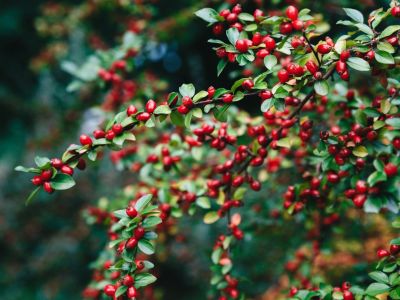Most plants have green leaves, so the question is: What plants have red berries? Read on for 10 great trees and shrubs with beautiful Christmas-red berries.
What Plants Have Red Berries?
Red berries on shrubs are more common than you might think, but not all bear fruit around the holidays. Some bloom in spring and fruit in summer, like high bush and low bush cranberries, strawberries, and raspberries; here and gone before the first frost. But other trees and shrubs that produce red berries hold onto the fruit all autumn and into the winter. These are the ones that give us most winter pleasure and help wild birds and small mammals make it through the cold season.
Red Berries That Grow on Bushes
- One berry bush that is less well known than the cranberry but equally beautiful is the red chokeberry bush (Aronia arbutifolia). The tart berries appear in summer and are excellent for jams. The bush has added ornamental appear the shiny green leaves turn reddish-purple in fall.
- Another plant with red berries that you may not know is the winterberry (Ilex verticillata). It’s a deciduous holly, not the kind you deck the halls with at Christmas, but a shrub that drops its leaves in winter. The gleaming red berries are loved by the birds and extremely ornamental.
- The bunchberry (Cornus canadensis) is a low-growing shrub in the dogwood family. It is extremely cold hardy, surviving weather down to -40 degrees in winter. It is an erect perennial, identifiable by its green leaves with parallel veins and the bunches of bright red berries. To add to its ornamental value, the bunchberry flowers in early summer, and its leaves turn brilliant red in autumn. This shrub is native to the north of the country and requires acidic soils.
- We’ve mentioned cranberry shrubs, but how about cranberry cotoneaster (Cotoneaster apiculatus)? It doesn’t get very high, no more than 3 feet (1m.) high, it makes up for it by spreading. The small, pink spring blossoms give way to round, blood-red fruit that last into winter.
- Who can resist a bush with a common name of wild coffee? Wild coffee (Psychotria nervosa) is an easy-care native shrub with tiny crimson berried and shiny green leaves. It’s a cold sensitive bush, but if you live in Florida, be sure to look for it.
Red Berries That Grow on Trees
- American holly (Ilex opaca) resembles English holly, one of the most famous plants with red berries and green leaves. The leaves are glossy with sharp spines and the berries are a jolly shade of red. The tree can grow to 50 feet tall (16m.) in mild climates.
- But that’s not the only holly that qualifies. Less famous, longstalk holly (Ilex pedunculosa) pleases with its spineless leaves, a rich, dark green, and shiny red berries. It grows to some 30 feet (10 m.) and is perfect for a specimen tree.
- Hawthorns (Crataegus spp) may have long, nasty thorns, but they also light up the winter with bright red fruits that hang on the tree into the cold season. The fruit follows white spring blossoms. persist into winter. You’ll find particularly appealing fruit with the cultivar Winter King hawthorn (Crataegus viridis ‘Winter King’).
- Eastern wahoo (Euonymus atropurpureus) generally stops growing at about 12 feet (4m.) tall, but we’re going to classify it as a small tree for the purposes of this article. This Iowa native starts off the growing season with dark purple spring flowers in late spring, followed by deeply lobed fruit. They spot open in fall to reveal red, berry-like seeds.
- Another small tree, staghorn sumac (Rhus typhina), is one of the first to blaze in fall foliage, its foliage morphing into yellow, orange and red. Female sumac trees produce upright fruit clusters, and the berries turn brilliant red in fall. They hang onto the tree through winter.
